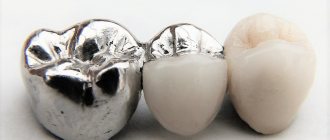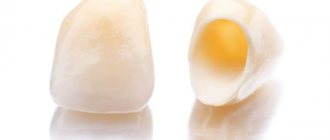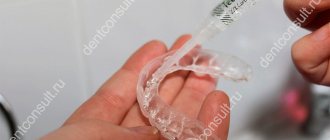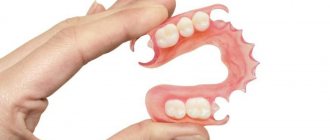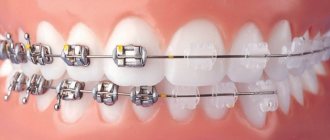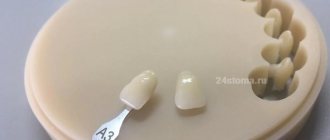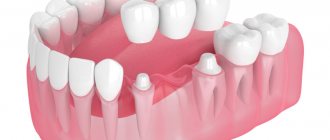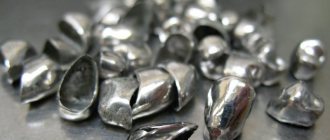Our teeth perform two important functions:
- We use our teeth to bite and chew food.
- Beautiful teeth make us more attractive
to chew food thoroughly is very important for human health.
If teeth are partially destroyed or, as a result of treatment, they have not been restored to their original strength, it is necessary to limit the consumption of solid foods, which means that the diet will be less varied.
The second function of teeth is purely aesthetic , but important for many public figures and everyone who cares about their appearance.
Depending on the degree of tooth destruction, its condition, position in the jaw and aesthetic requirements, doctors offer different restoration methods. You will learn more from the article Dental restoration. Filling, inlay or crown?
What is a metal-ceramic crown?
Today, the choice of materials for making dental crowns is very wide: ceramics, zirconium dioxide, and plastic, but metal-ceramics continues to be the most popular and affordable. At the moment, metal ceramics are a kind of gold standard in dentistry, since similar designs have been used by doctors for many years and have proven themselves to be good.
Metal-ceramic crowns are a “cap” with machined fissures, which is placed on a ground tooth and completely imitates its shape, including all anatomical formations. The basis for the structure is a metal frame, which is covered on top with a layer of ceramics, indistinguishable in color from natural enamel. The prosthesis is secured to the ground dental tissues using special composite or glass ionomer cement. In case of severe destruction, a metal tab is first installed, which serves as a reliable basis for the crown. Metal-ceramics are also used for the manufacture of bridges and clasp dentures supported both on the patient’s own teeth and on dental implants. In the latter case, the use of implants with metal abutments is recommended.
Stages of dental prosthetics
The quality of prosthetics largely depends on the correctness of the preparatory stage. Therapeutic tooth preparation includes:
- X-ray diagnostics, which allows you to identify hidden inflammatory processes and evaluate the quality of root canal filling - if a specialist detects violations, treatment is carried out before prosthetics;
- depulping the tooth eliminates the risk of inflammation due to thermal burns of the pulp;
- treatment of caries, removal of old low-quality fillings;
- making a core inlay for crowns if the coronal part is severely damaged, and in case of minor destruction, specialists use pins and filling material.
The specialist begins the immediate stage of prosthetics only after high-quality therapeutic preparation. The doctor grinds the tooth down to the thickness of the future prosthesis and makes an impression, which will be used to make a metal-ceramic crown in a dental laboratory. This will take some time, and during the prosthesis manufacturing stage the patient will wear temporary plastic dentures, which will hide from prying eyes and protect the ground teeth from the negative influence of the environment.
Pros and cons of a metal-ceramic crown
Among the advantages of metal-ceramic crowns is, first of all, their strength. Therefore, in most cases they are installed on chewing teeth. Undoubtedly, they look much better than purely metal crowns. In general, metal-ceramic crowns imitate real teeth well, but with the advent of new materials in prosthetics, preference in restoring anterior teeth began to be given to all-ceramic structures. When a combination of reliability and aesthetics is needed in the chewing area, then the best choice would be ceramic prostheses based on zirconium dioxide.
What is better to put on chewing and front teeth?
If the incisors or molars are well treated, only the crown part is destroyed, and the root is not affected by caries, there are no cracks or inflammations, crowns can be placed. But you need to choose the right materials.
Restoration of the anterior incisors must meet high aesthetic requirements. The best option is a single prosthesis made of metal-free ceramics (it has natural translucency, is as similar as possible to natural enamel, but does not withstand heavy chewing loads).
Chewing molars are subject to severe stress, so it is important that the restoration method is reliable. You should choose durable materials, the best is zirconium dioxide - it is not inferior in strength to metal ceramics, but is more aesthetically pleasing and durable.
If the dentist has doubts about the quality of treatment, it is better to perform an extraction and install implants. There are methods of immediate implantation immediately after removal into a fresh socket - this will shorten the treatment time, there is no need to wait for healing or restoration of bone tissue.
For anterior incisors, a prosthetic restoration can be placed immediately using an immediate loading protocol. It is better not to load chewing teeth immediately, but to carry out classical implantation with delayed loading, because implants can become dislodged when chewed.
What are the differences between metal-ceramic crowns?
Indeed, many patients wonder: what is better - zirconium crowns or metal-ceramics? Roughly speaking, both structures are metal-ceramic, but zirconium is a “white” material that does not shine through the ceramic, as sometimes happens with ordinary metal. Therefore, today ceramic crowns on a zirconium frame are close in aesthetic qualities to all-ceramic crowns, but at the same time they have the same strength as metal-ceramics. However, prices for such prostheses are higher than for metal-ceramic structures without the use of zirconium.
The question of which is better - metal-ceramic or ceramic crowns cannot be answered unequivocally. The choice is made depending on the indications and budget. So, if prosthetics of the frontal group of teeth is necessary, it is recommended to choose solid ceramics. It is aesthetic metal ceramics. Typically, such crowns are placed on teeth where the chewing load is less, since the metal-ceramic frame is stronger. Regarding the issue of price, a metal-ceramic crown is, of course, cheaper.
Types of metal-ceramic crowns
Metal-ceramic crowns have several classifications: according to the frame material and according to the ceramic material. Thus, according to the frame material, crowns are distinguished based on a chromium-nickel alloy, based on a cobalt-chromium alloy, and based on a gold-platinum (palladium) alloy (based on the so-called “noble alloys”). There is also another material that is used quite rarely - titanium alloy. Each of these types of metal-ceramic crowns has its own pros and cons. Traditionally, the most popular material is cobalt-chromium alloy. Based on the ceramic material, a distinction is made between conventional (high-temperature) and low-temperature ceramics. Low-temperature ceramics based on “noble” alloys look more aesthetically pleasing.
Indications and contraindications for metal-ceramic crowns
The indications for installing a metal-ceramic crown are the same as for crowns made of other materials. The main one is the index of destruction of the coronal surface of the tooth, equal to 0.6. Also, indications for installing a metal-ceramic crown are:
- any non-carious lesions, for example, fluorosis or enamel hypoplasia;
- abnormal development and position of the front teeth in adults, which for any reason cannot be eliminated by orthodontic methods;
- pathological abrasion or wedge-shaped defect;
- aesthetic defect in the crowns of natural teeth (changes in color and shape, loss of shine, etc.);
- inconsistency of existing artificial crowns with aesthetic and functional requirements;
- metal-ceramic crowns can also be used as a splinting structure for mild to moderate periodontitis;
Each of the above indications should be considered in the context of a specific clinical case. Contraindications include, for example, bruxism, as well as periodontitis, accompanied by severe tooth mobility. In addition, fixed prosthetics on implants also involves the use of metal-ceramic crowns.
Is it possible to put metal-ceramic crowns on the front teeth?
It is possible if the patient’s budget does not allow for all-ceramic crowns. There are no medical contraindications to the manufacture of metal-ceramic crowns on the frontal teeth. However, aesthetics in this case recedes into the background. Such crowns will not look very natural. Therefore, it is still better not to place metal-ceramic crowns on the front teeth.
Installing a metal-ceramic crown on a tooth
- The first stage of installing a metal-ceramic crown can be called clinical. The doctor treats the tooth and its canals, prepares dental tissue for the future crown and takes an impression.
- After this, the laboratory stage begins: in the laboratory, a crown frame is made, which we then try on, check its reliability and fit to the tooth, correct defects, if any, and also choose the color of the future structure. The frame is then taken back to the laboratory, where a technician applies ceramic paste to it.
- When the crown is ready, the doctor invites the patient to an appointment and installs it.
While the prosthesis is being manufactured, which can last from one to two weeks, a temporary crown is installed on the tooth.
Metal-ceramic crown with shoulder
There are no metal-ceramic crowns with a shoulder. The tooth is ground with a shoulder, and the metal-ceramic crown is made with a ceramic shoulder. That is, the edges of the metal frame of the crown are lined with a special “shoulder” ceramic mass. This is done to improve the aesthetics of prosthetics with metal-ceramic crowns, as well as to prevent “cyanosis” (translucency of the metal frame) in the crown-tooth transition zone.
Price list for orthopedic treatment
| Name of service | Price |
| Solid metal crown Crowns are made from cobalt-chrome, nickel-chrome and titanium alloys. They are durable and good for restoring the chewing function of teeth, but do not restore aesthetics. Find out which crowns are not only durable, but also aesthetic | 10000 ₽ |
| Metal-ceramic crown Crowns consist of a cast metal base and a ceramic layer applied to the metal. Metal-ceramic crowns combine the strength of metal and the aesthetics of ceramics. Learn about the pros and cons of metal-ceramic restorations | from 16500 ₽ |
| Metal-ceramic crown on an implant | from 42000 ₽ |
| Zirconium dioxide crown Ceramic-veneered zirconium dioxide crowns are both durable and beautiful. Modern materials and technologies for the production of dental crowns make it possible to abandon the choice between “Reliability” and “Beauty”. Find out what it means to choose a crown without compromise | 38500 ₽ |
| Veneer Installing veneers on your front teeth is a sure way to a flawless smile. Veneers remove the space between teeth, change the color of darkened teeth, correct the position and shape of teeth, and cover fillings and chips. If you only agree to impeccable aesthetics in the “smile zone,” choose ceramic veneers. | 27500 ₽ |
| Permanent fixation of the crown | 1000 ₽ |
| Taking an impression | 1600 ₽ |
| Temporary crown The Dental Association of Russia (STAR) recommends the use of temporary dentures as a cosmetic and functional guideline for the manufacture of permanent denture structures. What else do you need to know about temporary crowns? | 2100 — 6500 ₽ |
| Stump tab | 7000 — 8000 ₽ |
| Removable acrylic prosthesis IVOCAP | 25000 ₽ |
| Clasp prosthesis | from 48000 ₽ |
| Flexible removable denture Acry Free Whatever opportunities modern dental implantation provides, there are patients who, for various reasons, cannot take advantage of this prosthetic technology. The Acryfree® material developed by the Israeli company Perflex makes it possible to produce aesthetic removable dentures that are completely biocompatible and do not contain components that cause allergic reactions. | from 42000 ₽ |
Service life of metal-ceramic crowns
How long does a metal-ceramic crown last? Modern products last on average about 10 – 12 years. If a chip occurs on the metal-ceramic crown of the ceramic layer, then in some cases repair is possible. If it did not occur due to the development of secondary caries under the prosthesis, but as a result of mechanical damage, the dentist assesses the volume of the chip and, if the metal frame is not exposed, restoration of the metal-ceramic crown can be carried out using grinding or composite materials. If a serious chip occurs on the metal-ceramic crown, the prosthesis must be replaced.
Once the service life of the prosthesis has expired, the structure must be replaced. This is due to the fact that the special cement on which the structure is attached begins to deteriorate over time under the influence of saliva and other factors. If the crown is not removed in time, a problem may arise such as secondary caries, developing under the cap and at its junction with the tooth tissue.
Sometimes the difference between implantation and crown installation is only a couple of thousand rubles
Sometimes the difference is only a couple of thousand rubles due to the need for preliminary treatment before installing an orthopedic structure. If the tooth is severely damaged, additional costs will be required - strengthening with a pin or inlay. The patient pays for depulpation and root canal treatment. In addition, caries often develops under the denture. Even with good treatment, the root with the removed nerve is vulnerable to infection and is fragile, it can break even under light load.
Levin Dmitry Valerievich
Chief physician, Ph.D.
Implants come with a lifetime warranty. The most that will need to be replaced is a prosthesis. As research has proven, the service life of orthopedic structures based on artificial rather than living roots increases by 30–40%. With daily careful hygiene, the service life coincides with the implants.
Caring for metal-ceramic crowns
The rules for caring for metal-ceramic crowns are practically no different from the rules for caring for natural teeth. However, less interdental plaque and tartar are formed on the metal-ceramic surface than on natural enamel. For care, it is necessary to use dental floss, brushes and, preferably, an irrigator to avoid the accumulation of plaque at the transition boundary from the crown to the tooth. During the professional hygiene procedure, the structure must be polished. Otherwise, timely attendance at preventive examinations and thorough daily cleaning will help the metal-ceramic crown serve its full service life.
How much do metal-ceramic crowns cost in Moscow?
The price of metal-ceramic crowns per tooth depends on the price category of the clinic in Moscow, the metal used to make the frame, the qualifications of the prosthetist and dental technician, the complexity of the clinical case and a number of other factors. The price of a metal-ceramic crown for one tooth starts from 7,000 rubles. However, it does not include additional costs. The total cost of a dental crown made of metal ceramics, including taking impressions, installing a temporary crown and fixing a permanent one, is about 10,000 rubles, which, in general, is very inexpensive in Moscow.
What to choose - to summarize
| Implant | Crown | |
| Traumatic installation | high | short |
| Speed of tooth restoration | 2-6 months | from 2 days |
| Reliability of fixation | very high | above average |
| Need for replacement | No | Yes |
| Possibilities | any missing tooth | if there is no fracture and inflammation at the root |
| Life time | for life | 5-15 years |
| Price | high | depends on the need for pre-treatment |
Implants are reliable and durable. They imitate the structure of an incisor or molar. The lifetime service life of the titanium rod can be guaranteed. But surgical intervention is a necessary measure; no implant can replace a natural root. The dentist’s task is to preserve even part of the element of the dental system. A well-treated tooth and a correctly installed orthopedic structure create conditions for long service life and high aesthetics.
On the other hand, a root without pulp can no longer be called complete. Without nutrition, tissue breaks down, leading to organ loss. Then, in order to pay twice, it is better to install the implant immediately.
The doctor will tell you what is best to choose after diagnosis and examination.

